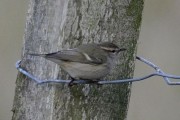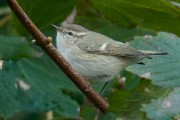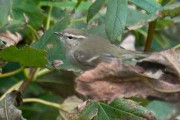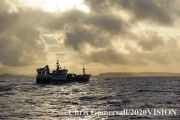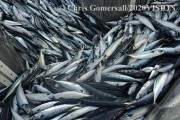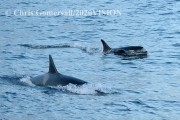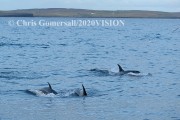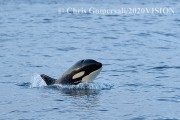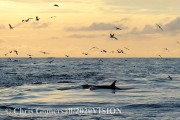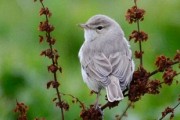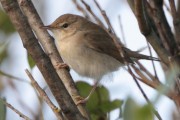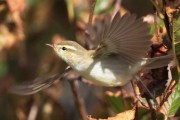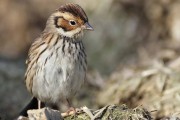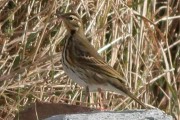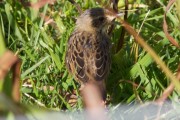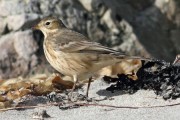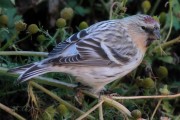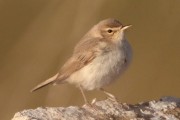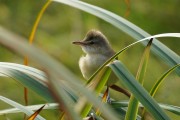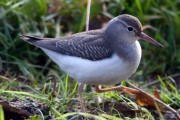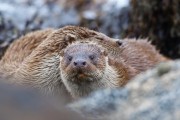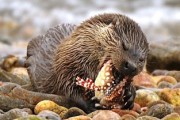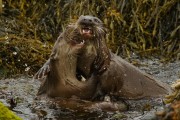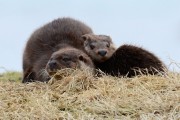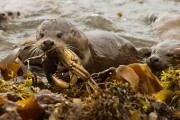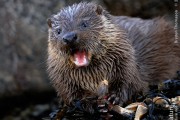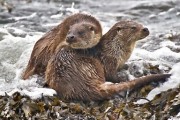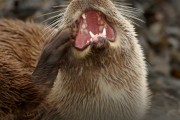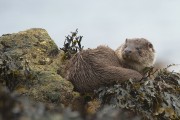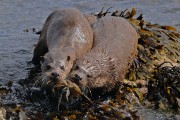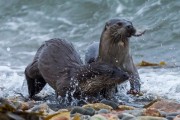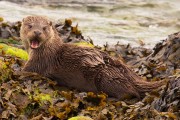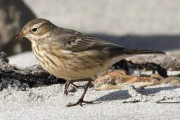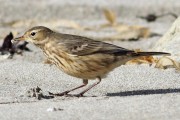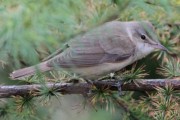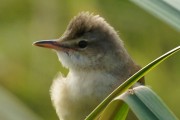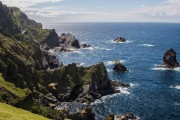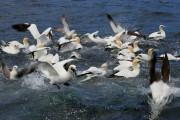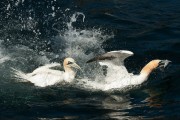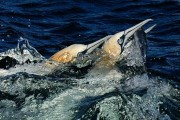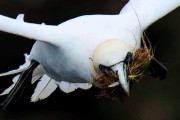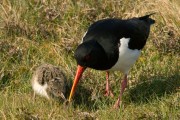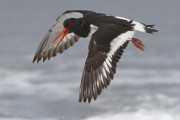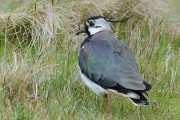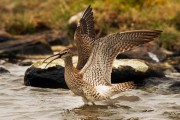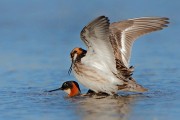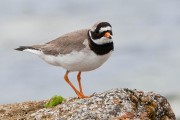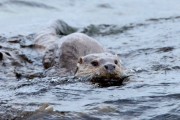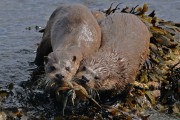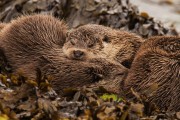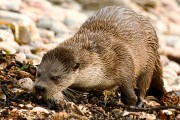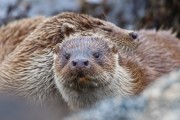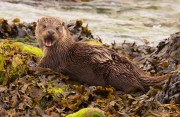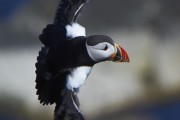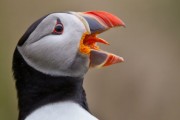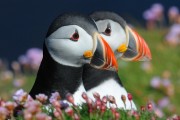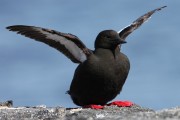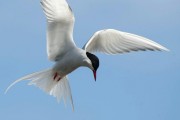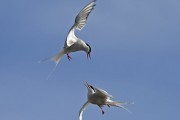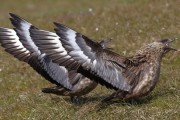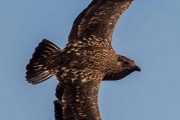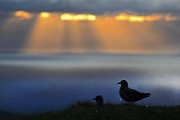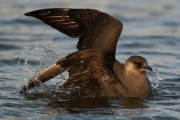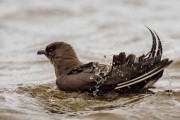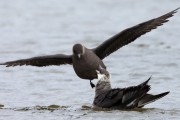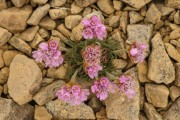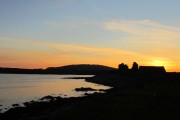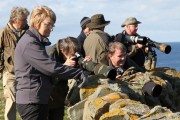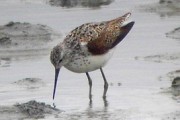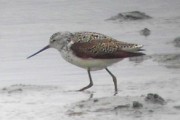Hume’s Warbler, Valyie, Unst – 16/10/12
Posted by Brydon Thomason on Thursday 1st November 2012 | Birding in Shetland
It had been many weeks since I had caught up with Paul Harvey and even longer since we had been birding together so with a day freed up to spend birding Unst on the 16th October, we set out full of optimism. With a generous scattering of October scarce and rare migrants over the past few days and conditions being favourable for more, we felt that our optimism was not misplaced.
But the reality is however, that the days where optimism is rewarded are greatly outnumbered by days of disappointment, but that’s what ‘the hunt’ is all about. This is of course one of the many advantages of birding as a team though; over and above the obvious advantage of an extra pair of eyes, company is good for morale.
At our first port of call our optimism was however rewarded with an Olive-Backed Pipit at Skaw, ‘that’ll do nicely’, we agreed although we couldn’t help hoping it would be our aperitif for something a little rarer. Barely an hour later we arrived at the rarity renowned hotspot of Valyie at the northern end of Unst. This mature wooded garden (by Shetland standards that is) is surprisingly difficult to work on your own but working together as a team you stand a much better chance of good coverage. With Paul on the outside I worked my way through the inside.
On nearing the bottom end of the garden, from just beyond a dense canopy of sycamore I could hear a faint and very intriguing call which sounded familiar enough to me to think it from a phyloscapus warbler but yet I couldn’t place which; a soft single ‘Siberian Chiffchaff’ like note (already heard earlier that morning), repeated three to four times followed by a more Siskin like disyllabic call. So momentarily perplexed was I that I even called Paul who I thought might be ‘at it’ with the iPod again, as he had been earlier in the day by playing calls off of ‘Eastern Vagrants’! But Paul was out of earshot. Just seconds later I heard the call again, prompting me to leave the trees and find Paul.
We discussed the call and I mentioned perhaps a Pallas’s warbler, more by associating the call with what I thought that species sounded like as apposed thinking it sounded like one (I have yet to actually hear one in Britain). Hume’s was also mentioned but these calls didn’t fit for what I was familiar with for that species. While waiting for the bird to show Paul played Pallas’ and Hume’s calls from the iPod, ever hopeful l (!), but there was no response. However although the Pallas’s call from the trusted iPod sounded similar, more importantly one of the three Hume’s calls was also a close fit and known to be similar.
Again the benefits of team work in these situations are invaluable both for the ID process and combined input and to piece together and process the identification. A brief glimpse of the bird fly catching as it flit between sycamore canopies was enough for us to see it was clearly a Yellow-browed type. After a brief glimpse of the bird we both enjoyed better views. Its dingy plumage, blackish bare parts and what looked like only one fairly broad buffy-white wing bar (with the second barely noticeable) was enough for us to be confident it was indeed a Hume’s.
It was frustratingly difficult to get views of the bird, so realising it was working a circuit of the garden, and only showing at certain parts we decided to stay close to what appeared to be its favourite feeding area. On our next view we confirmed the features above and then heard it calling several times and I also managed to photograph it. There was no doubt it was a Hume’s Warbler. What was very interesting about this Hume’s was the set of calls it gave and how much they varied. The typical and diagnostic disyllabic call most associated with the species was only given twice that day and not until much later. The other two calls were a single note of an even pitch and a more Siskin-like call with some downward inflexion. All three call-types are actually given on the Eastern vagrants CD. Despite playing these calls, however, the bird never really responded. Initially locating this bird up on call is quite typical of how many good birds are found. It is perhaps not easy to familiarise yourself with all the calls of everything you hope to find but knowing that something is different to the norm is extremely helpful!
Funnily enough, the following day when I returned to see if it was still present, and before I even saw it, it gave the classic and typically disyllabic Hume’s call which I am more familiar with several times. After not being seen for a week it reappeared on the 24th.
This was only the second for Unst following the one we found in back in 2008 (on a more typical date in early November). This is by far the earliest record for the species in Shetland and only the fourth year it has been recorded here.
Read about last year’s team found Hume’s warblers;
Permalink
Killer Whales and the Mackerel fishing industry in Shetland
Posted by Chris Gomersall on Wednesday 24th October 2012 | Sea Mammals in Shetland
Although Killer Whales cashing in on purse-net fishing by local boats has been known in Shetland waters for some time, in recent years this spectacle has received considerable media coverage, even making it onto national television. To summarise this spectacle, these whales essentially follow the mackerel migration, feasting on them as they go. As the vessels begin to haul their nets the whales tune into the change in revs from the vessels engines and home in to hoover up excess spillage of mackerel from the boats vast nets. SN team member Chris Gomersall shares his account from a recent photographic assignment aboard one of these vessels.
For the third year in a row, I find myself spending much of October in Shetland. And it’s not the rare birds that bring me here, exciting as that might be. What started as a photography assignment for the 2020VISION project has become a bit of a personal obsession, and I still have some unfinished business, in the shape of a massive, black and white torpedo with an over-sized dorsal fin. The killer whale. The trouble is, they don’t always arrive on cue. Or even appear at all.
The logistics of this operation are quite complicated, and entirely beyond my control. To summarise, it involves going out to sea as a guest on a pelagic mackerel trawler. Sometimes (as last year), we end up in Norway, waiting several days for some vital spare part to arrive from Sweden. Usually it’s the fish markets and the global price of mackerel that dictate when the season will commence; weather is very much a secondary consideration. Anyway, after ten days of hanging around, trying not to get impatient and filling my time quite pleasurably visiting old friends in the islands and stalking otters on the shore, my friendly skipper decides the time has come. At this point, I have no idea whether we will be gone for a couple of days or a couple of weeks, but I’ve cleared my diary as best I can and hope for as much sea time as possible. It’s a late night departure, via the fuel berth in Lerwick. Now, for anybody who might be feeling pangs of sympathy for me having to endure a long voyage on a trawler in the North Sea in the autumn, I ought to just point out that I have sailed on far worse cruise ships – these modern 70 metre vessels are not only highly technological they are also very comfortable for the crew, but of course they are still working boats – just very different from the deep sea Grimsby trawlers I remember from my youth. So there’s no need to pity me.
As it turns out, we don’t have to steam very far before we encounter the fish shoals, just outside St Magnus Bay, and as luck would have it it’s a beautifully calm day – which means I can observe from the foredeck. There are fabulous views of Papa Stour, Foula and the Eshaness cliffs in the early morning light, and the slight swell makes for good cetacean-watching conditions. In the distance, somewhere over near Hillswick, I see some wispy splashes that turn out to be dolphins breaching. Only two or three, quite fast-moving, but no discernible features at this range – possibly white-beaked dolphin? Then, just off our bows, a larger whale surfaces briefly: unmistakably a minke. Unfortunately it doesn’t reappear, and another photo opp vanishes with it.
Meanwhile, the fishing is going well, and our first haul of the net brings in a large bag of mackerel, but attracts no orcas. Hours pass, and as the sun lowers I see a tall whale spout against the light in the west. Just the once, and I have little idea what it might be, but presumably a large rorqual of some description. Frustrating, this whale-watching! Our second haul is more productive, from my point of view, and as the nets are being cleaned after all the fish have been pumped aboard, I spot the distinctive dorsal fin of a bull orca, closing in fast. It’s soon clear that he’s not alone, and we have a small pod of about a dozen orca around the boat. By now it’s about 5pm, and the whales stay with us for 20 minutes or so, occasionally spy-hopping for the briefest of moments, and not quite posing long enough for me to train my lens on them. As we trail the net and pick up speed, stray fish fall away and this prompts a bit more activity from the orcas, including some breaching. I photograph what I can, using two camera bodies – one fitted with a 200-400mm zoom lens, the other with a 70-200mm.
Naturally there are more misses than hits. They don’t break surface for long, and usually by the time you’ve found the animal in the viewfinder, pressed the shutter, and the camera mirror has moved out of the way, your subject is back underwater again! So there’s a lot of guesswork, and sighting along the top of the lens trying to anticipate the next leap. And all too soon, the whales peel off and go to look for the next boat that’s got fish. Our crew make another good catch, and unbelievably the fish holds are full within the first 24 hours, so it’s back to Lerwick for us.
It actually takes longer to pipe the fish in to the processing factory than it does to catch them in the first place. There’s nothing left for me to do except book my return trip on the Northlink ferry, and maybe start dreaming about October 2013. Of course I will be back in Shetland before then, joining Brydon Thomason in leading two wildlife photographic workshops in June 2013 – when there’s always the chance of orcas close inshore!
Chris Gomersall
Permalink
A purple patch of good finds for the team
Posted by Brydon Thomason on Thursday 11th October 2012 | Birding in Shetland
Following relentless strong westerly winds towards the latter part of September, it seemed as if the winds would never change. Accompanying the Red-Eyed Vireo (which at the time of writing is in second place for bird of the year in Shetland, pipped to the post by the mega Magnolia Warbler on Fair Isle!), was a scattering of Pectoral Sandpipers which rewarded many hours in the field for a couple of the team. But often in Shetland during the rarity renowned last week of September, all it takes is a break in the weather, when the wind drops off completely and all is calm and you just know its game on! This was exactly how the weather systems appeared to fall into place from the 21st September…
As is so often the case, birding, or perhaps more so rarity hunting, is much more enjoyable and indeed productive as part of a team. This was certainly the case for myself and birding comrade Micky Maher over that week which saw us enjoy a nice run of good finds together including two Blyth’s Reed Warblers, a Booted Warbler as well as the Greenish Warbler at Norwick we found with our good friend Mr P, AKA Mike Pennington. However the Great-Reed Warbler they found at Norwick was a much rarer bird in autumn in Shetland, being only the third ever recorded in the isles in this season. They are normally more ‘on the radar’ in spring here. A good haul of at least five Little buntings were a nice little supporting cast throughout the week with Roger and Gary turning up two in the South Mainland. Funnily enough two of the three Micky and I found together were at the same sites of both the Booted Warbler and one of the Blyth’s Reeds!
With the finding of the Booted Warbler as we were pieceing together our first adrenalin fueled views, we could hear a buntings ‘tick’ call continually – we almost didn’t know where to look! But that is autumn in Shetland and just how it can often be. Crazy to think that a bird as gorgeous as a Little Bunting, (after landing on the fence to confirm it was not a species that might eclipse the Booted) can be so quickly dismissed! It was almost the exact same scenario a few days earlier when we were cautiously trying to ID the Blyths Reed at Halligarth next door to my house; a Little Bunting and a Hawfinch were both in the Sycamores above the roses it favoured!
On this same day as our Booted and just ahead of leading our Autumn Birding holidays, Martin Garner got into the grove of the Shetland action with Roger Riddington scoring with an Olive-Backed Pipit while Rory Tallack proved once again that birds can turn up any where in the isles by finding a Lanceoleted Warbler way out on the West side of Shetland’s Mainland. This was indeed quite a discovery for such a sought after North Isles speciality normally associated with smaller islands such as Fair Isle where it is renowned.
Moving into the end of the month the good fortune continued with Micky finding a superb Hornemann’s Redpoll with Pierre-Andre Crochet on Unst which along with a Pechora Pipit in the same area proved to be two extremely popular birds for visiting birders. Another popular and obliging rarity was the Spotted Sandpiper, initially found by Ryan Irvine and co-identified by Micky. Probably most popular of all and indeed rarest find was the Buff-Bellied Pipit found by Roger and perhaps best of all was that it was found by carrying out the once a month voluntary beached bird survey with his wife Agnes, a memorable Sunday outing indeed!!
For more of Shetland’s latest bird news (and to see all the other highlights from this amazing week) we recommend following our close friends at Nature in Shetland on facebook where you will also find link to their sightings page and website.
There is plenty of the autumn still to come, we hope our team finding purple patch continues!
Permalink
Review of Otter Photography Season 2012
Posted by Brydon Thomason on Monday 8th October 2012 | News, Otters
Another fantastic season of Otter encounters and images. Again 2012 was an extremely busy season and is far from over at the time of writing! Even in the ‘shoulder seasons’ of late winter into early spring my 1-to-1 Otter photography itineraries continue to be popular. Of course the core season between May and August each year is in growing demand and has sold out over recent seasons but also now the off peak seasons are becoming more and more popular for photographers seeking to study, learn about and photograph these wonderful animals. This is of course little wonder, as I study Otters all year round and the winter is a fantastic time to study Otters behaviour as it is well known for them to condense their feeding activity into the available hours of day light.
Each year it is inspiring how many photographers come to photograph Otters but also how far they come. This year as well as from the UK I enjoyed the company of guests from all over including the USA, Germany, Netherlands, Belgium and France to name but a few. Adding to the growing number of top professionals seeking Otters in the isles this year I had Neil McIntyre out with me, who enjoyed some wonderful encounters and left with great images;
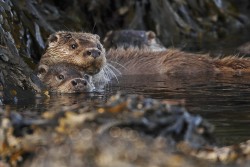 Otters have long since been a species have I wanted to photograph and although I have had a few brief encounters have never managed anything great. A couple of colleagues mentioned Brydon’s name to me and to get in touch with him about my forthcoming trip to Shetland. Once there I meet up for 2 of the days with Brydon. The first day we did not have a lot of luck, however we thoroughly enjoyed the day and learnt so much by listening and watching Brydon. On the second day I think we saw in the region of 8-10 otters, with one particularly fantastic encounter with a mother and 2 cubs. I have to say Brydon’s local knowledge and enthusiasm is wonderful and anyone going to Shetland would be wise to get in touch with him, not only for otters but for all of Shetlands wildlife. Since my trip to Shetland I have since had a few of my own otter encounters on other locations and the experience of being out with Brydon helped enormously.
Otters have long since been a species have I wanted to photograph and although I have had a few brief encounters have never managed anything great. A couple of colleagues mentioned Brydon’s name to me and to get in touch with him about my forthcoming trip to Shetland. Once there I meet up for 2 of the days with Brydon. The first day we did not have a lot of luck, however we thoroughly enjoyed the day and learnt so much by listening and watching Brydon. On the second day I think we saw in the region of 8-10 otters, with one particularly fantastic encounter with a mother and 2 cubs. I have to say Brydon’s local knowledge and enthusiasm is wonderful and anyone going to Shetland would be wise to get in touch with him, not only for otters but for all of Shetlands wildlife. Since my trip to Shetland I have since had a few of my own otter encounters on other locations and the experience of being out with Brydon helped enormously.
Neil McIntyre
Here is a further selection of some of this years guest images (and a couple of my own), accompanied with a few words of their time with Otters. If you are interested in joining me in 2013 it is strongly advised to get in touch soon, there are few dates left available, as usual June and July are long full with March, April and May similarly so, the diary is fast filling in, availability is limited but i will do what I can…
Hi Brydon – here are a few from that magical day when you took us to this otter family. I’ll never forget the experience and also the hard work you put in to give us the photo opportunity – many thanks. I hope to return some day for another visit to Shetland and more otters. Once again, thanks for all your hard work.
Neil MacGregor
Thank you for a great day that has left an indelible mark on my wildlife memories. I found your experience and knowledge of otters exeptionally helpful. Your passion and energy for the day offset and motivated what was an energetic walk, until the magical moment we sat down and watched an otter family appearing out of the surf, photographing them until they once again returned to the sea. I wish you every success that you rightly deserve in all your adventures and that many more photographers/guests will enjoy such memorable moments.
Steve McLaren
Click here for information on my Otter Photography trips..

Permalink
Buff-Bellied Pipit, Rerwick beach, Scousbourgh
Posted by Roger Riddington on Sunday 30th September 2012 | Birding in Shetland
In 15 years of helping out on the monthly beached bird surveys in Shetland, my highlights so far have both been dead ones – a Brunnich’s Guillemot and a Great Shearwater (both in 2007) – but I have long hoped to find a decent live bird while trogging round my three Shetland beaches. On 30th September 2012, the miles walked eventually paid off.
The day was bright, sunny and pleasantly mild, with a moderate to fresh SW wind, There was not much in the way of new birds being reported that weekend and my plan was to do beaches before a big breakfast. My wife Agnes came out with me, and we covered Scousburgh and Peerie Voe before heading to Rerwick, the beach on the north side of the Bay of Scousburgh. We were almost at the easternmost end of the beach, and I was scanning through half a dozen Alba Wagtails and 10+ Rock Pipits, when one particular pipit jumped out at me with strongly and pretty uniformly buff-washed underparts. Almost immediately it took off and flew down the beach with a call that sounded to me just like a Meadow Pipit! I was confused but still thought that it was probably a Buff-bellied Pipit – but one that was clearly not nailed. I left Agnes holding my coat and bins and ran up the cliff to get my camera. Back down on the beach ten minutes later, I approached the west end of the beach, where the bird had flown off to. Eventually, I refound it, on its own, near the stream – it was indeed a BUFF-BELLIED PIPIT! Fantastic! It called several times more – most of the calls sounded exactly like the previous Buff-bellied Pipits I’d heard in Shetland, but one other set of calls also sounded – to me – just like a Meadow Pipit.
This is the 10th BBP for Shetland, following four on Fair Isle (one found a few days before this one), three on Foula and two others on Mainland, all bar one of the Fair Isle ones since 2007. Interestingly, I think it is the first to be found (and primarily seen) on a beach – in contrast, most of the ones seen in Iceland are on beaches.
That same weekend, Mike Pennington found a Pechora Pipit in Unst while doing his beached bird surveys. If you live in Shetland and you don’t contribute to the survey – maybe you should!
Roger Riddington
Be sure to check out last year’s sighting of a Buff-Bellied Pipit by Martin Garner.
Permalink
Great Reed Warbler, Norwick Unst
Posted by Micky Maher on Saturday 22nd September 2012 | Birding in Shetland
On the 22/09/12 of September Mike Pennington and I set out to the Northern sites in Unst, as we had so many times before. Migration at Skaw, so often the birding barometer of the isle appeared scant, so we trudged off to Valyie, Norwick. On walking alongside the tatties, oats and grasses, we saw a couple of Barred Warblers and a Yellow-browed Warbler.
A large warbler was flushed from the crop and flew over a trailer at the bottom of the incline. It looked tawny with a long, floppy tail. As I walked towards where it had landed the bird flew, up on to a fence and showed really nicely, heart racing thoughts of Thick-billed Warbler were soon replaced by, sorrow and defeat, as we saw the dark lores long bill and wings of a beautiful Great-Reed Warbler, the third record in autumn for Shetland. We then showed the bird to Tony Davidson and friends who were walking along the Norwick road towards our position, before legging it back to Mike’s for literature, to try and ‘rule in’ Oriental Reed Warbler. Another fantastic day team birding, spent with an excellent bird in Shetland.
Interestingly, until the Norwick bird, there had been three autumn Thick-billed Warblers in Shetland. Mike Pennington had also found one of the previous two Great-Reed Warblers!
Micky Maher
Permalink
Review of the Shetland Nature Photography Holiday 2012
Posted by Brydon Thomason on Sunday 22nd July 2012 | News
A round up by David Tipling of this year’s two week-long Shetland Nature Photography holidays, with a selection of photos from our guests, to whom we are grateful for image use in this review:
As southern Britain suffered monsoon like weather this June, on Shetland our two nature photo tours enjoyed some of the driest brightest conditions I have encountered in 30 years of visiting the Northern Isles.
The highlight for most were close encounters with Otters, made possible by Brydon’s experience, local knowledge and fieldcraft. Bird photography was however outstanding at times, from Puffins amongst Thrift in beautiful light to Gannets diving within a metre or two of our wide angle lenses.
Our Arctic Skua bathing pool site, offered some participants their first taste of being in a purpose built hide, though somewhat rustic in build it consistently produced not just great Arctic Skua images but Whimbrel and Golden Plover for some lucky people.
Hermaness is always a highlight of these tours from the teeming Gannet colony to marauding Great Skuas. This year a beached Sperm Whale carcass provided an added attraction and nearby both Golden Plover and Oystercatcher were photographed at close range, brooding day old chicks.
These tours always offer opportunities for everyone to learn off each other. This year was no exception as we grappled with photographing Arctic Terns hovering above us against white skies to give striking high key images, to stitched panoramics of Muckle Flugga against a stunning sunset.
It was a wrench for me to leave. I can’t wait for June 2014 when I will be leading another Shetland Nature photo tour.
David Tipling
July 2012
2012 Guest reviews:
Hello Brydon
I really enjoyed my trip with you and David.
The people skills of the both of you make everybody feel very welcome and that can make or break a trip. There are very few companies that deliver what they promise in their brochures or on their website but you do more than that. Having been on a Shetland trip before showed me how much your company stands out. Never had I thought to see wild otters this close in their environment. It was only possible because of your tracking skills and great knowledge about otters. The choice of taking only two people at a time to minimise disturbance works very well. So while some two people are off to find otters others of the group are photographing birds from a hide near the bathing pool of the arctic skuas. This hide gave good opportunities for getting pictures of all kinds of bathing birds. I also enjoyed Hermaness for photographing sea birds.
The combination of seeing and photographing otters and birds make this trip stand out from other trips offered on Shetland
If at all possible I will be back to Shetland to do another trip with you.
Keep up all the good work Dick van der Lely
Just a quick note to thank you for an excellent week in Shetland, and of course, especially for the otters! It really was a wonderful experience and I’m delighted with images I got from the day. The full frame head shots were the ones I expected to be favourites, but of course those could be taken anywhere, so the ones of the cubs fighting in the surf I think will be the ones that will be special when I look back after a while. The rest of the trip was great and I’ll look forward to coming back again. Thanks also for your tremendous enthusiasm and for sharing your knowledge of Shetland. Dave Bartlett
The bird experience led by David was excellent. Stunning sightings and lots of fun. Brydon taught me so much about photographing Otters. I came away with shots every one of which is in a totally different league to any I have taken previously. A great experience. Richard Bennett
“Hi Brydon, David and Team. Sorry I’m slow replying but 6000 pics takes me a lot of sorting! I’m probably not ruthless enough yet but I’m still trying to discover what I think makes a good pic. Thank you for a great Holiday, which also gave me great opportunities to find, see and photograph various wildlife that I have failed to find for years. I learnt a lot re technique. With the chance to argue out the pros and cons with experienced photographers my pictures clearly improved during the week. A special thank you to Brydon, the Otter-Spotter, for the fantastic opportunities he consistently found for us all. James Hogg
Find out about our 2013 dates led by Chris Gomersal and Brydon Thomason →
Permalink
Marsh Sandpiper at Virkie – The Second Shetland Record
Posted by Rob Fray on Saturday 14th July 2012 | Birding in Shetland
Finding rare birds is sometimes the result of hard work, skill and determination. On other occasions, it can be down to luck. The latter was the case with Shetland’s second ever Marsh Sandpiper…
My brother Richard had arrived from Arizona in early July, bringing with him a group from Borderland Tours, and I had agreed to help out with guiding them for their trip to Shetland (don’t tell Brydon about this bit of ‘moonlighting’). Our plan for Saturday 7th July was to sail round Noss on the ‘Dunter’ to look at the gannetry, but the rather unseasonal weather (a north-easterly gale) scuppered that idea, with the pre-booked ferry trips being cancelled the previous night. Richard and I discussed what we could do instead. I had noticed a few waders outside my house on the Pool of Virkie early in the morning, including Knot and Bar-tailed Godwit (which, as the majority of the guests on the trip were from America, was of interest to them); that was our new plan for the morning sorted.
By about 09:30 we were all in situ, in the turning circle in front of my house, scanning the pool. A Knot and a couple of Bar-tailed Godwits were visible distantly at the east end of the pool, near the Ness Boating Club, so being ‘lead driver’ I took the first minibus up the road for a closer look. The short journey was rudely interrupted when a small group of Redshanks took to flight, accompanied by a smaller wader which, to the naked eye, appeared to have a white rump. This was clearly going to be something ‘different’. Minibus brought to an abrupt halt, I quickly scanned through the Redshanks, which had landed a little distance away. Imagine my surprise, as the saying goes, when I clapped eyes on what looked for all the world like a summer-plumaged Marsh Sandpiper! I couldn’t remember whether this was a first or a second for Shetland, but whichever it was, it was mightily important.
The next five or ten minutes were a combination of chaos and comedy. I leapt out of the minibus to get my ‘scope out of the boot, whilst trying to use a walky-talky to alert Richard in the other minibus about what I’d just seen. A few garbled messages later and I think he got the general gist of what I was trying to say. The leg fell off my tripod whilst I was trying to scope the bird, at which time I swore (politely) a lot and the guests in my minibus all started looking at me with a mixture of amusement and pity (whilst not really knowing what on earth was actually going on). The Marsh Sand flew, and I couldn’t see it any more. One of Richard’s group then refound it, and Richard got a look at it too, only for a low-flying helicopter to flush all the waders on the pool in all directions. I was getting more stressed and more incoherent by the minute, but thankfully the bird reappeared again, much closer and appearing a little more settled. Anybody with a camera was ordered to take a photo of the small boring grey wader in front of us, and ignore the nice brightly-coloured godwits and Knot for the time being. I was now a bit calmer, and managed to text out the news without any more mishaps.
The bird continued to be very flighty, and behaved as though it had only just arrived in Shetland. Marsh Sandpipers are not usually associated with tidal habitats such as the Pool of Virkie, being more of a freshwater species, so maybe its erratic behaviour reflected this. It only remained at Virkie for a few hours, before flying off over Toab and being relocated later in the day at the more suitable site of Loch of Hillwell. It was not seen on subsequent days.
This is only the second Marsh Sandpiper to be seen in Shetland; the first was way back in 1969, at Strand, so was a Shetland tick for almost everybody. There have been just eight previous Marsh Sandpipers recorded in Scotland, the last of these being in Highland in October 2000.
As mentioned in the opening lines of this write-up, luck can play a huge part in finding rare birds. Had it not been for a couple of cancelled boat trips, we would have been happily sailing round Noss and nowhere near the Pool of Virkie. For once, the sometimes nasty summer weather in Shetland was a bonus.
Finally, thanks to all on the Borderland Tours trip, who put up with their guide having a total meltdown in front of them! I think everybody enjoyed themselves.
Rob Fray
Permalink


